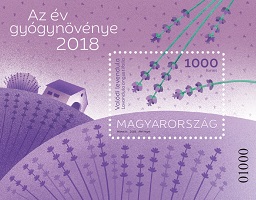
Az év gyógynövénye - Valódi levendula - Bélyegblokk
A Magyar Posta alkalmi bélyegblokkot bocsát ki a valódi levenduláról, amelyet 2018-ban a Magyar Gyógyszerésztudományi Társaság Gyógynövény Szakosztálya az év gyógynövényének választott. A sorszámozott blokk 70 000 példányban, Maros Krisztina grafikusművész tervei szerint, az ANY Biztonsági Nyomdában készült. A kiadvány 2018. május 2-án jelenik meg, és ettől az időponttól kezdve kapható az elsőnapi postákon, a Filapostán, továbbá megrendelhető a Magyar Posta internetes áruházában is.
A gyógyszerészet és a gyógynövények története évszázadok óta szorosan összefonódik. Bár a modern gyógyászatban a növényi kivonatok alkalmazása kisebb jelentőségű, mint korábban, a legújabb gyógyszerhatóanyagok ma is jelentős részben természetes eredetűek, több száz növényi molekulából kifejlesztett gyógyszervegyület létezik. Napjainkban is számos növényi kivonatot tartalmazó gyógyszer, gyógytermék és sok ezer étrend-kiegészítő kapható.
A valódi vagy keskenylevelű levendula (latinul: Lavandula angustifolia) az ajakosok családjába tartozó, 40-60 cm magas, félgömb alakú, örökzöld, évelő, mediterrán eredetű félcserje. Kékes-lilás színű virágai június végén nyílnak. A Magyar Gyógyszerkönyvben szárított virága és a belőle nyert illóolaj hivatalos. Levendula fajokat már az ókorban is alkalmaztak gyógyászati célból sebek fertőtlenítésére, valamint álmatlanság kezelésére. A valódi levendula Benedek-rendi szerzetesek révén terjedt el Európában, a XV. századtól dísz- és aromanövényként Magyarországon is ültetik. Hazai ipari célú termesztését Franciaországból származó tövek telepítésével 1920-ban Bittera Gyula indította el a Tihanyi-félszigeten. Napjainkban a legkedveltebb gyógynövények egyike, és egyre több helyen termesztik. A fitoterápiában a levendulavirágot elsősorban teaként nyugtalanság, álmatlanság kezelésére, emésztési panaszok enyhítésére alkalmazzák. A növény illóolaját aromaterápiás szerként is használják, valamint a kozmetikai ipar fontos alapanyaga.
A Magyar Gyógyszerésztudományi Társaság Gyógynövény Szakosztálya 2013-ban indította útjára az év gyógynövénye kezdeményezést, amelynek fő célja a növényekkel történő gyógyítás népszerűsítése és a lakosság tájékoztatása a gyógynövények szakszerű alkalmazásáról. Az év gyógynövénye lehet bármely növény, amely a vele kapcsolatos új tudományos eredmények révén az érdeklődés fókuszpontjában van és része a modern terápiának.
A blokk grafikáját a valódi levendula virágzatára utaló lila szín uralja, ami megidézi a Nap és a széles levendulaföldek hangulatát. A népi motívumokra hasonlító, leegyszerűsített ábrázolás kiemeli a növény elegáns megjelenését. Az alkalmi borítékon és az alkalmi bélyegzőn szintén a bélyeg motívumai jelennek meg.










